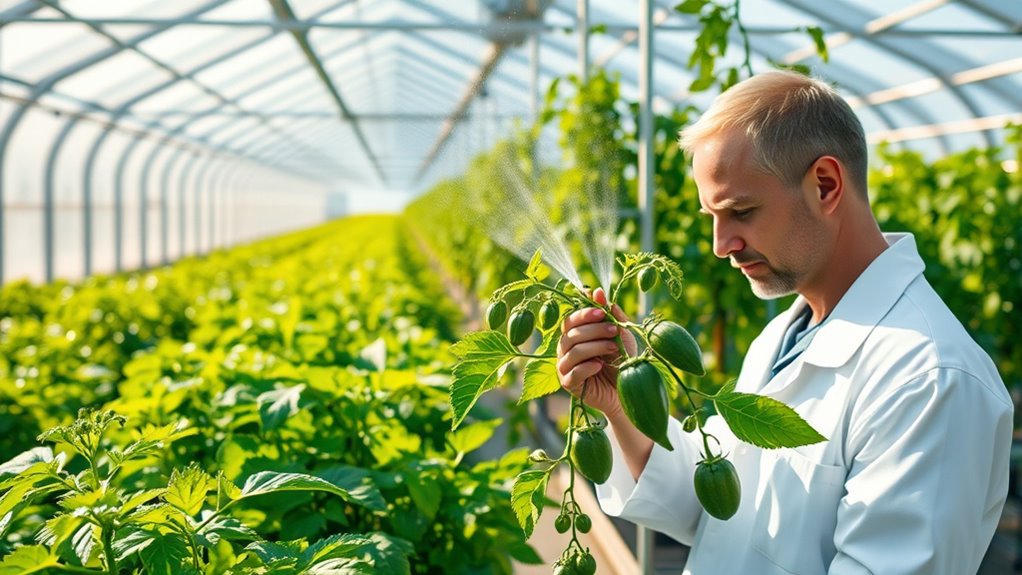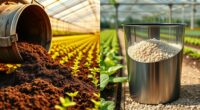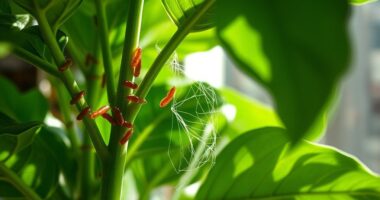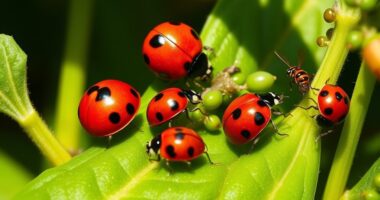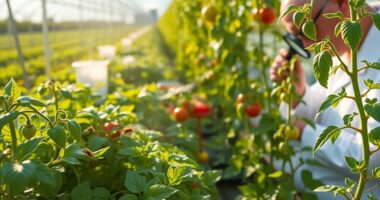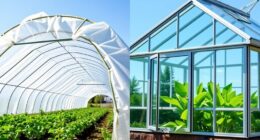Recent advances in greenhouse pest management focus on combining biological controls, like predatory insects and microbial agents, with advanced monitoring tools such as AI and sensors for real-time detection. You can optimize strategies through genetic approaches, climate control, and eco-friendly biopesticides. Integrating these technologies helps create sustainable, effective pest control methods that reduce chemical use. Keep exploring these innovations to discover how they can transform your greenhouse pest management practices even further.
Key Takeaways
- Advances in AI-driven sensors enable real-time, early pest detection, enhancing precision in greenhouse pest management.
- New microbial biocontrol agents, such as genetically optimized Bacillus strains, improve pest suppression efficacy.
- Development of climate control strategies disrupts pest lifecycles by manipulating temperature, humidity, and light conditions.
- Integration of drone technology and data analytics offers targeted, eco-friendly pest monitoring and intervention options.
- Innovative breeding techniques utilize molecular markers to develop pest-resistant crop varieties for sustainable IPM.
Biological Control Agents: Nature’s Allies in Pest Suppression
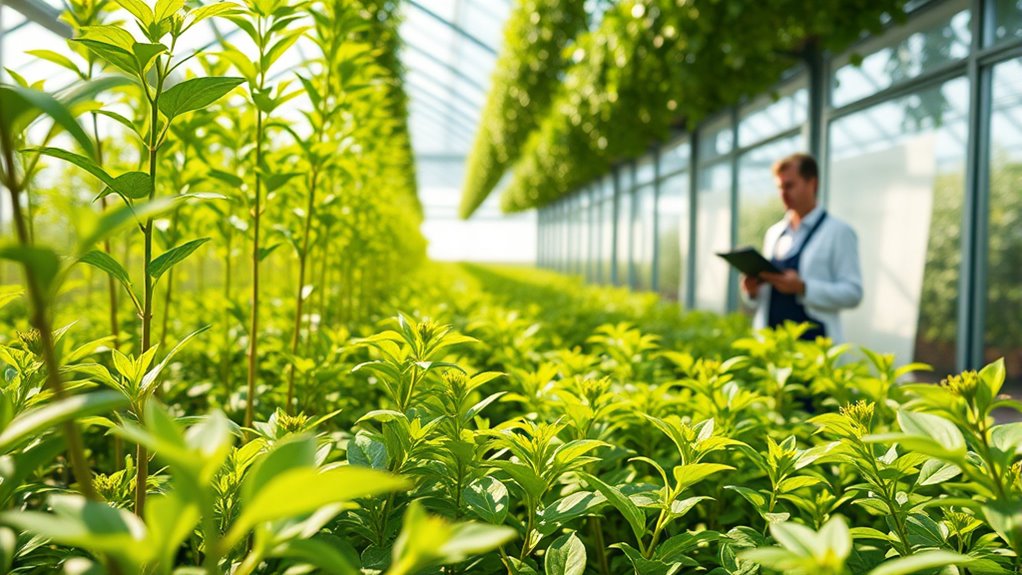
Biological control agents play a crucial role in managing pests naturally within greenhouses. By integrating these beneficial organisms, you support pollinator health, which is essential for crop productivity. Healthy pollinators thrive when habitat diversification is prioritized, offering them food sources and shelter. These agents help reduce pest populations without relying on chemical pesticides, promoting a balanced ecosystem. As you diversify habitats, you encourage the presence of natural enemies, improving pest suppression. This approach not only protects pollinators but also enhances overall plant health. Incorporating community support initiatives can further strengthen sustainable pest management practices. Using biological control agents aligns with sustainable practices, ensuring your greenhouse remains productive while minimizing environmental impact. Additionally, fostering habitat diversification can lead to a more resilient environment that naturally keeps pests in check. By fostering habitat diversification and supporting pollinator health, you create a resilient environment that naturally keeps pests in check.
The Role of Predatory Insects and Microorganisms in Greenhouse Environments
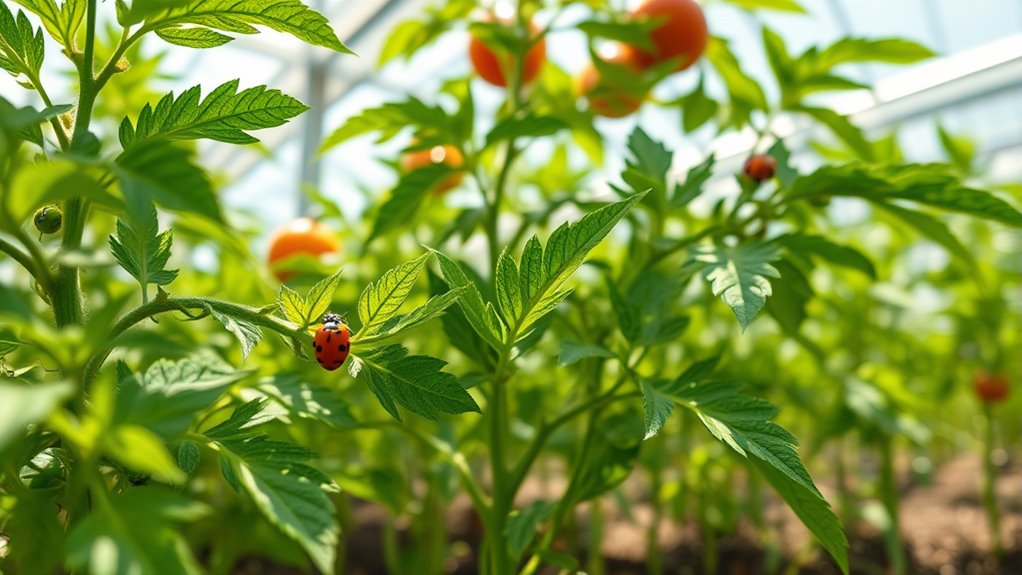
Predatory insects like ladybugs and predatory mites actively hunt pest species, while beneficial microorganisms help strengthen the soil microbiome, improving plant health and resilience. A healthy soil microbiome promotes vigorous plant growth, making pests less likely to cause damage. Additionally, these natural allies support pollinator populations by minimizing chemical use that could harm them. Implementing biological control methods reduces reliance on chemical pesticides, fostering a safer environment. Maintaining proper habitat conditions for beneficial insects can further enhance their effectiveness in pest suppression. Gold IRA fees are also an important consideration when evaluating investment options, as they can impact overall returns. Together, predatory insects and microorganisms create a balanced ecosystem that enhances pest management, crop productivity, and environmental sustainability in greenhouses. Their integrated role underscores the significance of biological control in modern greenhouse practices.
Advances in Pest Monitoring Technologies Using AI and Sensors
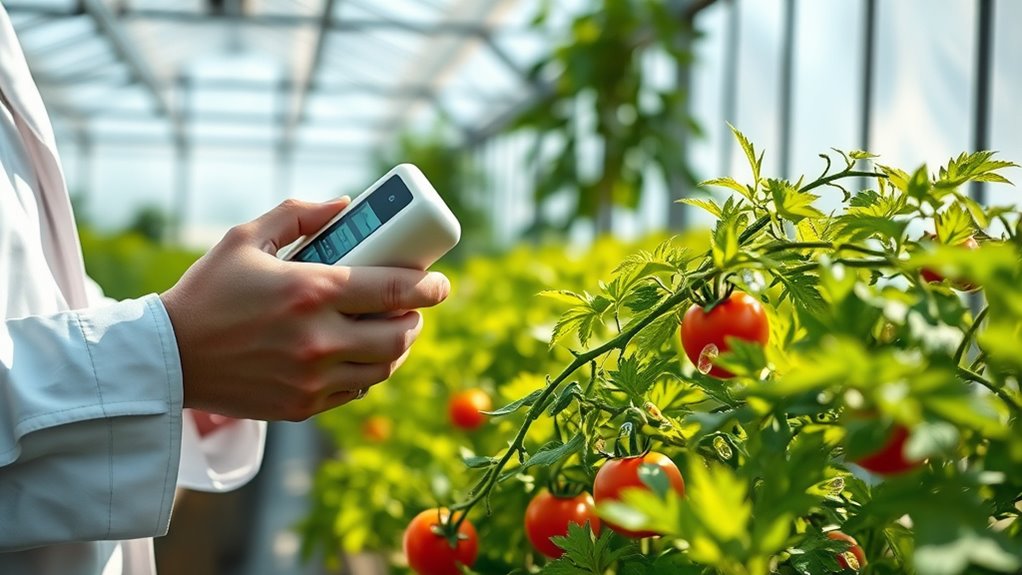
AI and sensors are transforming how you monitor pests in greenhouses, providing real-time insights that were previously impossible. With AI-driven pest detection, you can identify infestations early and accurately, saving time and resources. Sensor-based techniques allow you to continuously track environmental conditions and pest activity, making your pest management more precise and effective. Incorporating pest monitoring technologies can further enhance detection accuracy and response times, leading to healthier crops and more efficient operations. Additionally, integrating vibrational detection methods can help identify pest presence through subtle environmental cues, improving early intervention. As technology advances, integrating these tools with sustainable practices can promote environmentally friendly pest control solutions. Ongoing research in machine learning algorithms continues to refine detection capabilities, leading to smarter pest management strategies. Moreover, utilizing real-time data analytics can optimize intervention timing, reducing chemical usage and supporting eco-friendly methods.
AI-Driven Pest Detection
Advances in pest monitoring technologies are transforming how growers detect and manage pests in greenhouses. AI-driven pest detection uses machine learning algorithms and high-resolution imaging to identify pests early, even before they establish a pest habitat.
This technology helps you assess crop vulnerability by pinpointing infestations precisely, reducing unnecessary pesticide use. With AI, you gain real-time insights that improve decision-making and target interventions efficiently.
- Detects pests on leaves and stems instantly
- Differentiates pests from other objects
- Monitors pest activity patterns continuously
- Alerts you to emerging infestations
- Reduces crop damage and pesticide reliance
Sensor-Based Monitoring Techniques
Building on AI-driven pest detection, sensor-based monitoring techniques offer a proactive way to manage greenhouse pests. These sensors track soil health, humidity, temperature, and pest activity in real-time, helping you detect issues early. By integrating AI, you can analyze sensor data for patterns indicating pest resistance or soil deterioration, enabling targeted interventions. This approach reduces chemical use and promotes sustainable pest control. Use the table below to understand key sensor applications:
| Sensor Type | Focus Area | Benefit |
|---|---|---|
| Soil Moisture | Soil health | Prevents overwatering, improves pest resistance |
| Temperature Sensors | Pest activity monitoring | Identifies optimal pest development conditions |
| Pest Traps with Sensors | Pest detection | Early identification, reduces outbreaks |
| Humidity Sensors | Environmental control | Maintains ideal conditions for plant health |
Additionally, understanding the contrast ratio of your sensors can help improve image-based pest identification accuracy, leading to more reliable monitoring outcomes. Incorporating sensor calibration techniques ensures data accuracy over time, further enhancing early detection capabilities and reducing manual oversight. Regular calibration and maintenance of sensors are essential for maintaining data reliability and ensuring optimal system performance. Moreover, understanding sensor placement best practices can significantly enhance the effectiveness of pest monitoring efforts.
Integrated Pest Management Strategies for Sustainable Greenhouse Cultivation
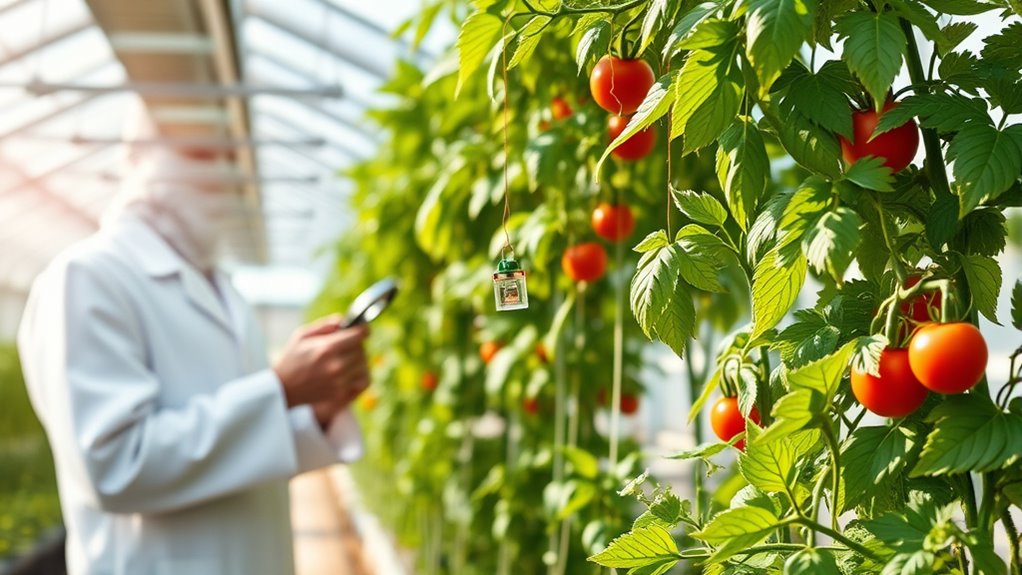
You can enhance your greenhouse sustainability by combining biological control methods with proper cultural practices. Sound design principles, such as creating a balanced environment, can support beneficial insects and natural pest control. Minimizing chemical use is also key to maintaining a healthy environment for plants and beneficial insects. Integrated pest management strategies create an effective, eco-friendly pest management system tailored to your greenhouse. Additionally, understanding the role of necessary cookies can help you optimize site functionality and access helpful resources for sustainable practices. Studies show that optimal angles for pinball machines can also serve as a fun analogy for the importance of precise adjustments in pest management techniques to improve effectiveness. Developing a self-awareness of your greenhouse’s unique conditions can further refine your pest control approaches for better outcomes.
Biological Control Methods
Have you considered how biological control methods can effectively manage pests in greenhouse cultivation? These strategies use natural enemies like predatory insects, parasitoids, and microbial agents to target pests.
By understanding pollinator interactions, you can enhance beneficial insect activity and improve pest suppression. Pest behavior modeling helps predict outbreaks, allowing timely intervention with biological controls.
Key techniques include:
- Releasing ladybugs for aphid control
- Using parasitic wasps against whiteflies
- Applying microbial agents like Bacillus thuringiensis
- Encouraging habitat for beneficial insects
- Monitoring pest populations with pheromone traps
Implementing these methods reduces chemical use, supports pollinator health, and sustains greenhouse ecosystems. Biological control offers a precise, environmentally friendly approach to pest management, aligning with sustainable cultivation goals.
Cultural Practice Optimization
Optimizing cultural practices enhances the effectiveness of biological control methods and supports sustainable greenhouse cultivation.
By implementing crop rotation, you can interrupt pest life cycles and reduce pest populations naturally. Rotating crops prevents pests specific to one plant type from establishing a foothold, decreasing the need for chemical interventions.
Maintaining soil health is equally important, as healthy soil promotes vigorous plant growth and resilience against pests. Incorporate organic matter and proper watering techniques to foster beneficial microbial activity, which suppresses harmful pests and diseases.
Additionally, adjusting planting schedules and spacing minimizes pest habitat and improves airflow, reducing humidity that favors pests. These practices create an environment less conducive to pests, making biological controls more efficient and supporting long-term sustainability in your greenhouse.
Chemical Use Minimization
How can greenhouse growers effectively reduce reliance on chemical pesticides while maintaining healthy, pest-free crops? One key strategy is integrating practices that bolster crop rotation and soil health, disrupting pest cycles naturally.
You can:
- Rotate crops to prevent pest buildup and reduce chemical dependence
- Use organic mulches to improve soil vitality and suppress pests
- Introduce beneficial insects to control pest populations naturally
- Employ biological agents like predatory mites or fungi
- Enhance soil health through composting and minimal tillage
These methods help build resilient plants and a balanced ecosystem, lowering the need for chemical interventions.
Genetic and Molecular Approaches to Pest Resistance and Management
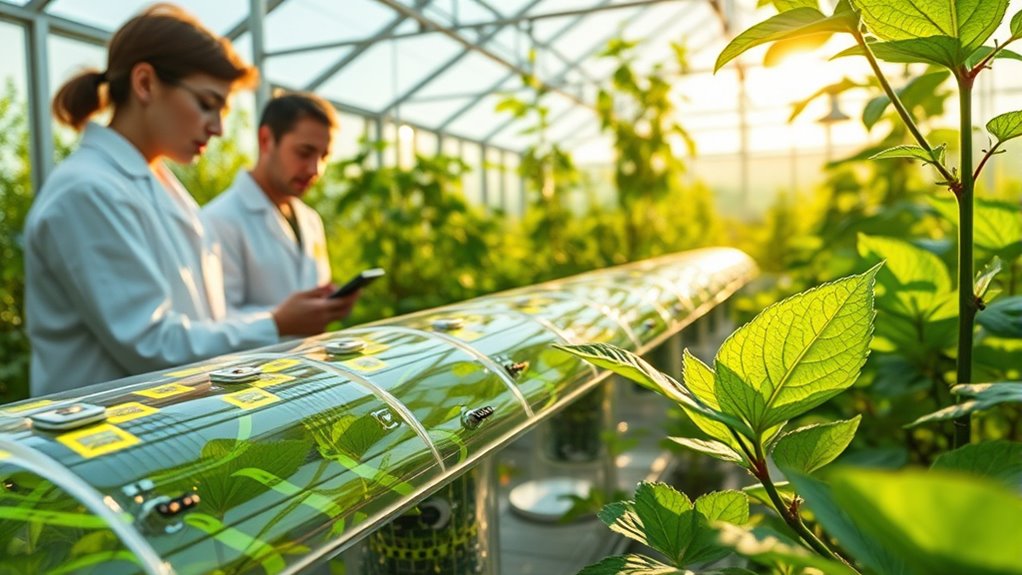
Genetic and molecular approaches are transforming pest management strategies in greenhouse agriculture by enabling targeted and sustainable solutions. You can use genetic modification to develop pest-resistant plant varieties, reducing reliance on chemical controls.
Molecular markers help identify specific genes associated with pest resistance or susceptibility, streamlining breeding programs. These tools allow you to select for desirable traits more efficiently, accelerating the development of resilient crops.
By understanding pest genetics at a molecular level, you’re better equipped to design precise interventions that minimize environmental impact. This approach also helps monitor pest populations and detect resistance development early.
The Impact of Climate Control on Pest Dynamics and Control Efficacy
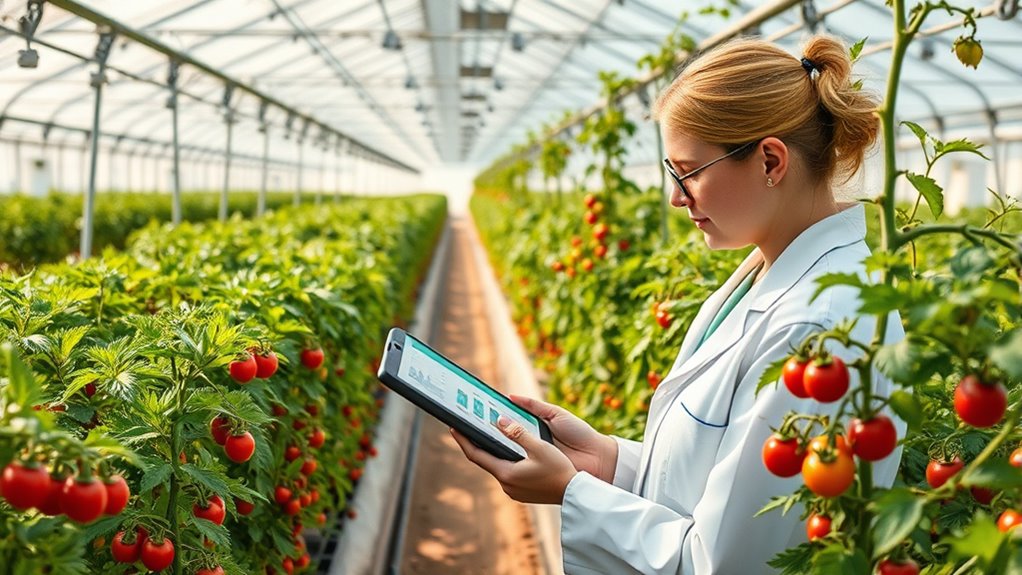
Advances in genetic and molecular pest management have improved your ability to develop resistant crops, but environmental factors like climate play a significant role in pest behavior and control success. Climate variability influences pest lifecycle timing, reproduction rates, and migration patterns, making pest management more complex.
When climate conditions fluctuate, pests may adapt faster, reducing control effectiveness. To stay ahead, consider how:
- Temperature shifts alter pest development speed
- Humidity affects pest reproduction
- Light levels influence pest activity
- Wind patterns spread pests across areas
- Seasonal changes impact pest emergence
Understanding these factors helps you optimize greenhouse climate control strategies. By managing temperature, humidity, and light, you can disrupt pest lifecycle stages, improve control efficacy, and reduce pesticide reliance. Climate control becomes a critical tool in maintaining a pest-resistant greenhouse environment.
Biopesticides: Developing Eco-Friendly Alternatives to Chemical Pesticides
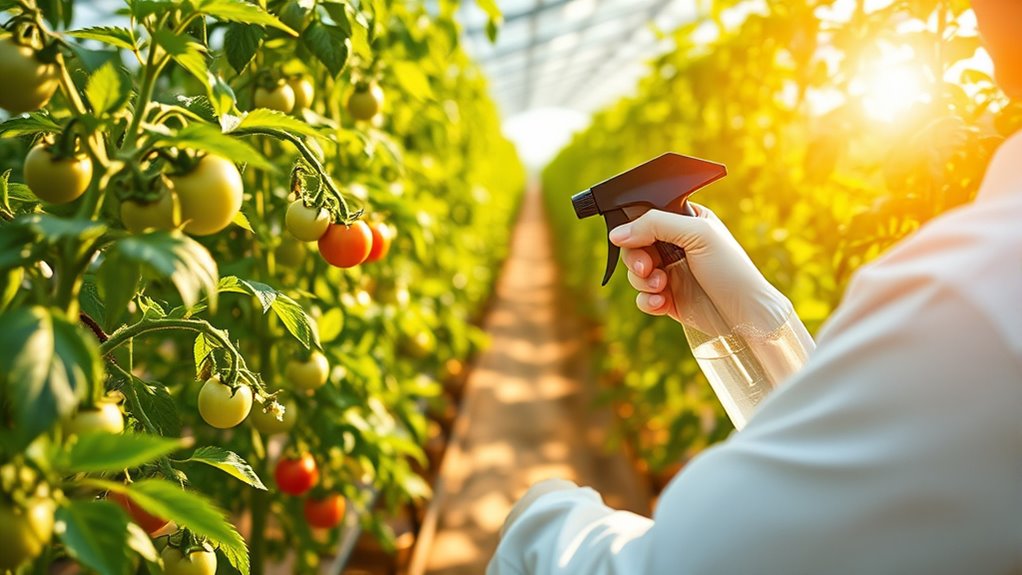
As concerns over the environmental and health impacts of traditional chemical pesticides grow, biopesticides have emerged as a promising eco-friendly alternative. These biological agents, including bacteria, fungi, and viruses, are integrated into various pesticide formulations that target pests without harming beneficial insects or the environment. You can enhance their effectiveness by combining biopesticides with crop rotation, reducing pest resistance and maintaining healthy soil. Proper application methods are vital for success. Here’s how different biopesticide formulations support sustainable pest management:
| Formulation Type | Target Pest | Benefits |
|---|---|---|
| Bacterial-based | Aphids | Eco-friendly, specific |
| Fungal-based | Mites | Reduces chemical use |
| Virus-based | Caterpillars | Biodegradable, safe |
Future Perspectives: Combining Technology and Ecology for Pest Control
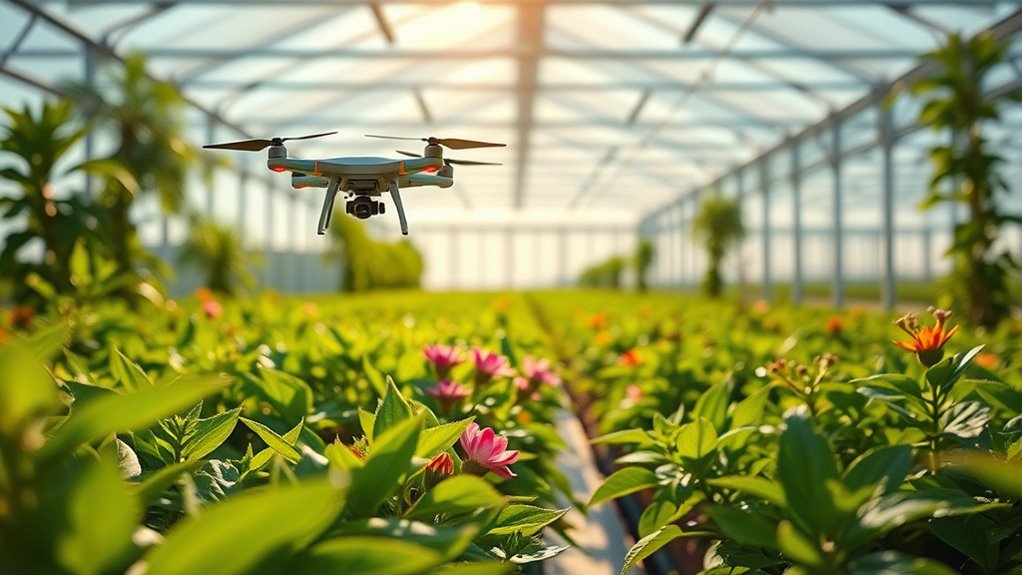
The future of pest control lies in integrating cutting-edge technology with ecological principles to create more sustainable and effective strategies. You’ll see drone surveys providing real-time images of pest hotspots, allowing targeted interventions. Data analytics help interpret these images, enabling precise decisions that reduce pesticide use.
Combining technology with ecology means promoting natural predators and habitat management alongside innovative tools.
- Using drones for rapid pest detection and monitoring
- Applying data analytics to predict infestations early
- Combining ecological methods with intelligent pest control systems
- Reducing chemical reliance through precise interventions
- Enhancing sustainability with adaptive, tech-driven solutions
This integrated approach empowers you to manage pests efficiently, minimize environmental impact, and promote healthier greenhouse ecosystems. Embracing these innovations will shape a smarter, greener future in pest management.
Frequently Asked Questions
How Do Pest Management Strategies Vary Across Different Greenhouse Crop Types?
You’ll find that pest management strategies differ based on crop-specific challenges and pest diversity.
For leafy greens, you need to focus on pest prevention methods that target aphids and thrips.
While flowering plants may require strategies addressing whiteflies and mites.
Tailoring your approach helps you effectively control pests, minimizes chemical use, and guarantees healthy crop production.
Understanding the unique pest profiles of each crop is key to successful greenhouse pest management.
What Are the Economic Benefits of Adopting Eco-Friendly Pest Control Methods?
This question isn’t just important—it’s a game-changer! By adopting eco-friendly pest control methods, you can achieve significant cost savings and meet rising market demand for sustainable products.
These methods often reduce chemical expenses and lower environmental impact, making your operation more efficient.
Embracing green strategies boosts your reputation, attracts eco-conscious customers, and ultimately increases profitability.
The economic benefits are undeniable, transforming your greenhouse into a model of sustainability and success.
How Do Seasonal Changes Influence Pest Behavior and Control Success?
Seasonal pest fluctuations markedly impact your pest control efforts, as climate influence causes pests to become more active or dormant at different times of the year.
You’ll notice pest populations rise during warmer months, making control more challenging, while colder seasons may naturally suppress pests.
Understanding these patterns helps you time interventions effectively, maximizing success and reducing chemical use, as you adapt your strategies to seasonal changes and climate influence.
What Training Is Necessary for Greenhouse Staff to Implement New Pest Management Technologies?
To effectively implement new pest management technologies, you need to focus on pest identification and staff certification.
You should train your team to accurately identify pests, understand control methods, and stay updated on best practices. This involves hands-on training, certification programs, and continuous education.
How Do Regulatory Policies Affect the Adoption of Innovative Pest Control Solutions?
Regulatory policies markedly influence how you adopt innovative pest control solutions. Regulatory hurdles can delay or complicate approvals, making it harder to implement new methods quickly.
However, policy incentives, like grants or streamlined approval processes, encourage you to try cutting-edge technologies.
Conclusion
So, as you embrace these eco-friendly pest control methods, don’t forget—nature’s “natural allies” might just surprise you with their resilience. While AI and sensors promise precision, pests continue to adapt faster than your latest tech. Ironically, the best defense is still understanding ecology and working with nature, not against it. So, enjoy the high-tech future, but remember, sometimes the old ways of pest management still hold the best lessons.
